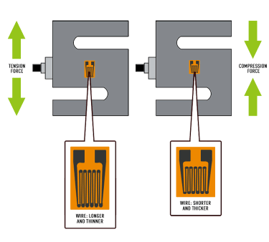One of the functions of an isokinetic dynamometer is to measure the amount of force the user of the machine is outputting. They do this in different ways, but one design goes as such:
- User applies force to the machine at it’s load cell (such as extending their leg like in the image above)

- The strain gauge in the load cell deforms from the force
- The deformation of the strain gauge causes a change in it’s electrical resistance.
- Using a Wheatstone bridge and voltmeter, the change in resistance can be measured.
So in the end, the computer program reads a voltage and from that determines the muscles force. It needs some sort of equation relate the two. We’ll walk through the steps in coming up with that equation.
- How does force deform the load cell?
When the user kicks his/her leg out against the machine, the load cell wants to stay in place, and the user isn’t able to accelerate the load cell no matter how hard they push. Since that force isn’t causing motion, it’s causing the load cell (and it’s strain gauge on the inside) to stretch a little bit, causing a CHANGE IN LENGTH. The load cell will follow the following response due to the stress it feels during the exercise:
 The materials chosen for the load cell will be such that the maximum force expected to be experienced by the machine would keep the plot in the linear, elastic region. In this region the load cell can elastically return to it’s original length when the force is removed and doesn’t permanently deform.
The materials chosen for the load cell will be such that the maximum force expected to be experienced by the machine would keep the plot in the linear, elastic region. In this region the load cell can elastically return to it’s original length when the force is removed and doesn’t permanently deform.
- We can determine the STRESS the load cell experiences if we control the LOAD CELL AREA. The MUSCLE FORCE is variable and depends on the user (see equation in plot)
- We can solve for STRAIN by using young’s modulus to relate STRESS to STRAIN
STRAIN=STRESS/YOUNG’S MODULUS - We can get CHANGE IN LENGTH if we know STRAIN and the ORIGINAL LENGTH Of the strain guage.
CHANGE IN LENGTH=STRAIN*ORIGINAL LENGTH - All together, the CHANGE IN LENGTH is given by this equation:

- How does deformation affect resistance of the strain gauge?
The load cell deforming causes the strain gauge to deform the same amount. Let’s assume the strain guage is a cylindrical wire.As long as the cross sectional area and resistivity of the wire are controlled, we can solve for the change in length to get the strain gauge’s electrical resistance.
- LENGTH OF WIRE=ORIGINAL LENGTH+CHANGE IN LENGTH

- Bringing it all together
 With resistivity, original length of wire be constants and cross-sectional area changed being assumed miniscule, so also constant for simplicity
With resistivity, original length of wire be constants and cross-sectional area changed being assumed miniscule, so also constant for simplicity
- How is change in resistance measured?
For this, a wheatstone bridge is used.
 Using the voltage divider rule we are able to know what the voltage at both sides of the path in the wheatstone bride above are. Using a voltmeter, we can read the difference in voltage across the two paths. The resistors R1,2,3 are all constants chosen by the designer. Only the strain gauge resistance is variable which scales based on the muscle force applied.
Using the voltage divider rule we are able to know what the voltage at both sides of the path in the wheatstone bride above are. Using a voltmeter, we can read the difference in voltage across the two paths. The resistors R1,2,3 are all constants chosen by the designer. Only the strain gauge resistance is variable which scales based on the muscle force applied.
Everything in this equation is constant besides muscle force. The material properties and sizes are all determined by the materials and dimensioning of the designer. Remember that we assumed that the cross sectional area of the wire remains constant. In actuality it thins a little as the wire is elongated, which would cause a a greater increase in the change in resistance than if it was constant. This greater increase in resistance would give us a smaller voltage readout.
Also, as the machine is used over time it’s material properties will degrade and some of the constants will shift, so calibration of this equation over time will be necessary for accurate results. But this gives us the fundamental equation to measure force using a dynamometer.
I hope that was easy to follow along. Of course, feel free to reach out in the comments below if you have any questions.






